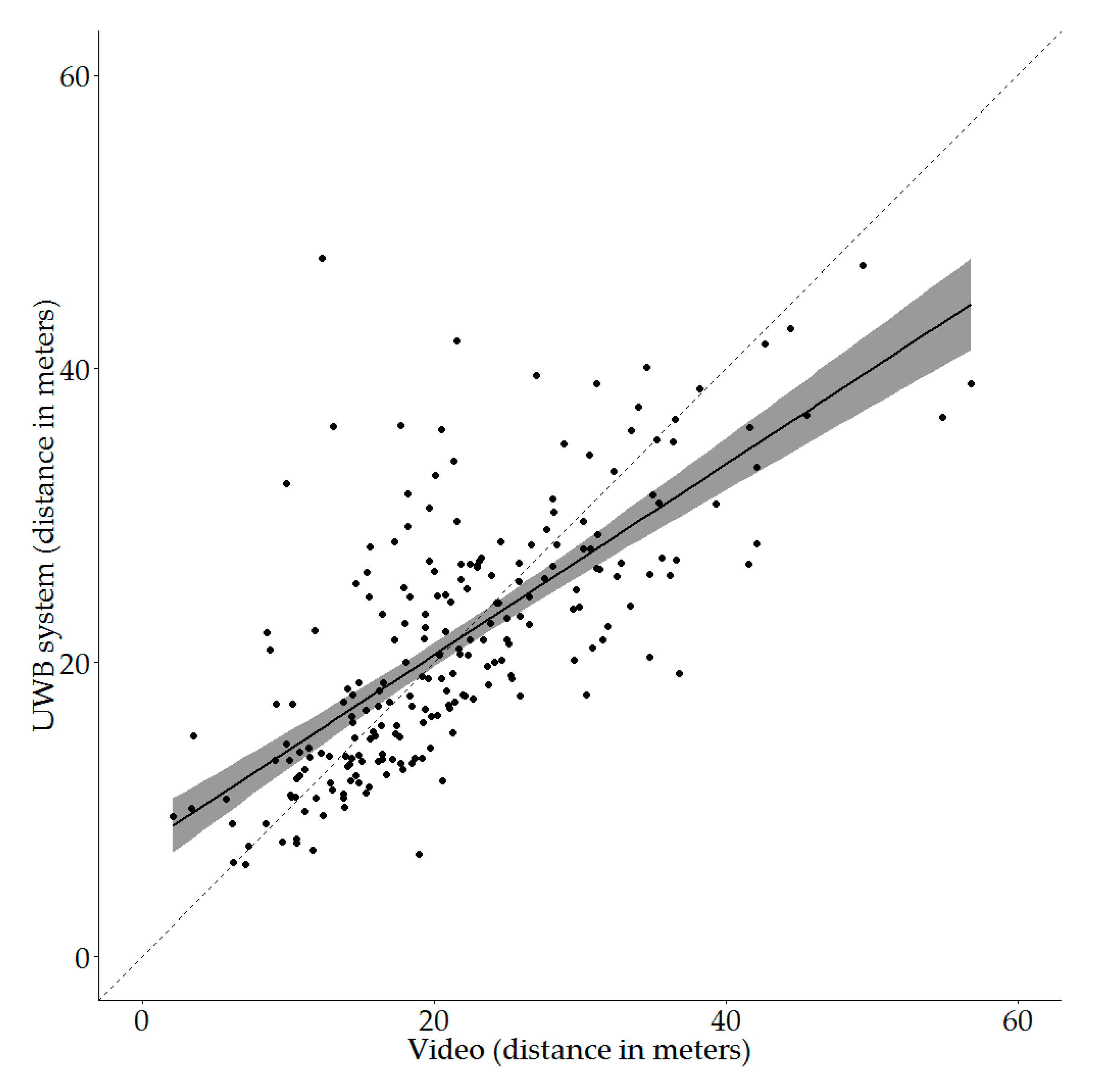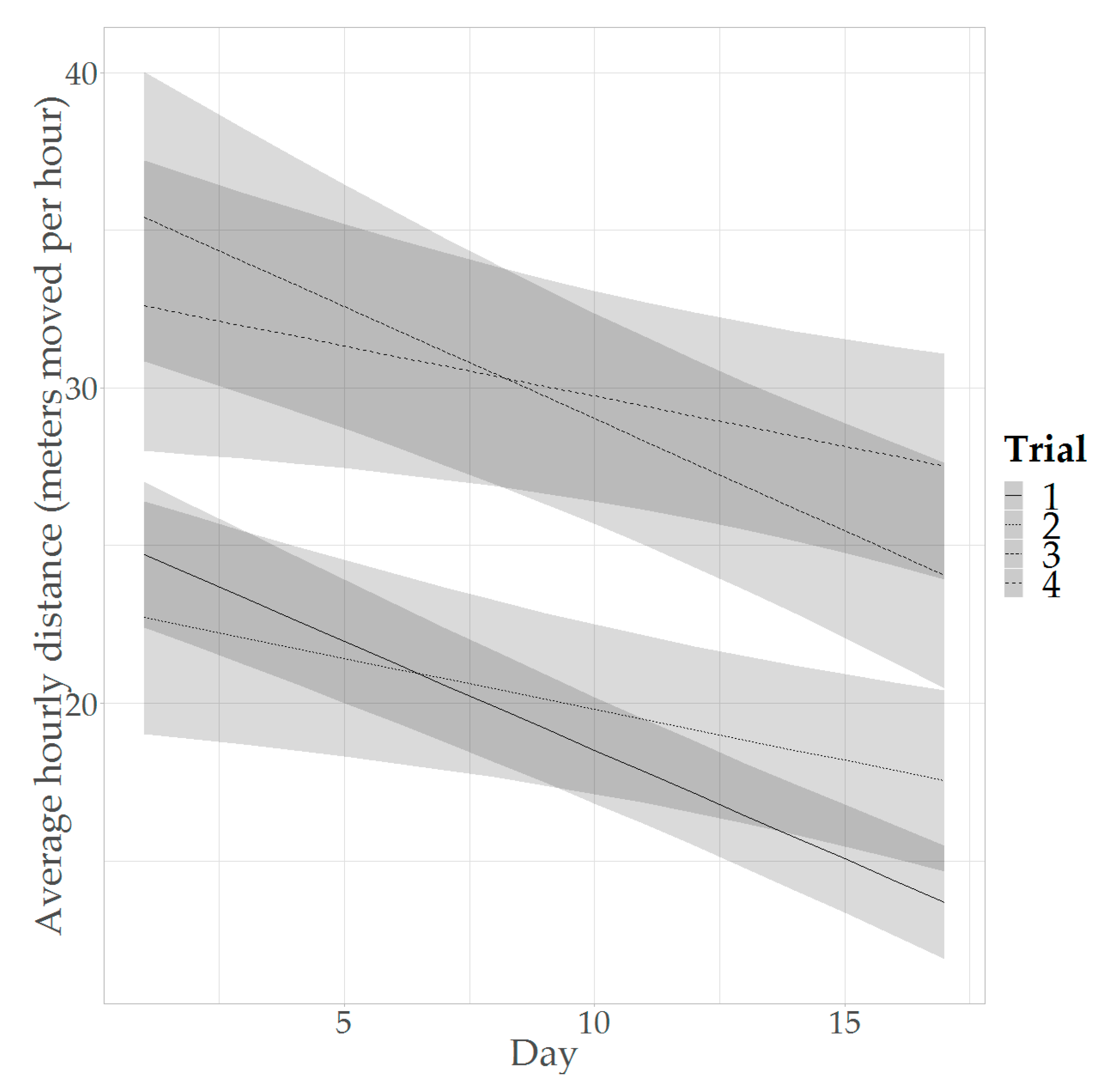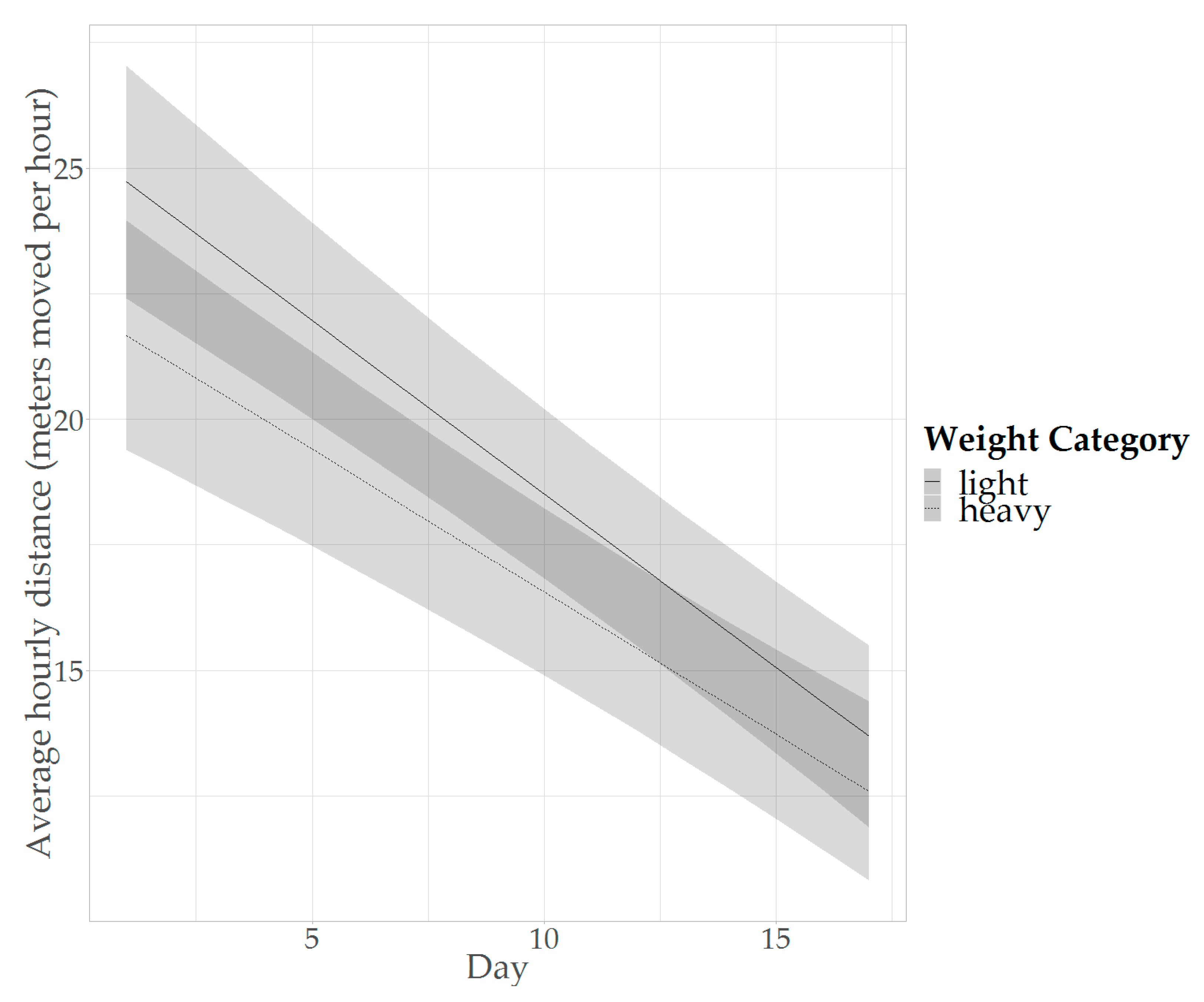Validation of an Ultra-Wideband Tracking System for Recording Individual Levels of Activity in Broilers
Abstract
Simple Summary
Abstract
1. Introduction
2. Materials and Methods
2.1. Ethical Statement
2.2. Location and Housing
2.3. Ultra-Wideband System
2.4. Distance Validation Study
2.5. Activity Trends Study
2.6. Statistical Analysis
3. Results
3.1. Distance Validation Study
3.2. Activity Trends Study
4. Discussion
4.1. Distance Validation Study
4.2. Activity Trends Study
4.2.1. Activity Levels over Time
4.2.2. Differences in Activity between Weight Categories
4.2.3. Effects of Trial and Cross
4.3. Activity as a Predictor
5. Conclusions
Author Contributions
Funding
Acknowledgments
Conflicts of Interest
Data availability
References
- Catarinucci, L.; Colella, R.; Mainetti, L.; Patrono, L.; Pieretti, S.; Secco, A.; Sergi, I. An animal tracking system for behavior analysis using radio frequency identification. Lab Anim. 2014, 43, 321–327. [Google Scholar] [CrossRef] [PubMed]
- Gregory, N.G. Physiological mechanisms causing sickness behaviour and suffering in diseased animals. Anim. Welf. 1998, 7, 293–305. [Google Scholar]
- Haye, U.; Simons, P.C.M. Twisted legs in broilers. Br. Poult. Sci. 1978, 19, 549–557. [Google Scholar] [CrossRef] [PubMed]
- Kestin, S.C.; Gordon, S.; Su, G.; Sørensen, P. Relationships in broiler chickens between lameness, liveweight, growth rate and age. Vet. Rec. 2001, 148, 195–197. [Google Scholar] [CrossRef]
- Van Hertem, T.; Norton, T.; Berckmans, D.; Vranken, E. Predicting broiler gait scores from activity monitoring and flock data. Biosyst. Eng. 2018, 173, 93–102. [Google Scholar] [CrossRef]
- Kestin, S.C.; Knowles, T.G.; Tinch, A.E.; Gregory, N.G. Prevalence of leg weakness in broiler chickens and its relationship with genotype. Vet. Rec. 1992, 131, 190–194. [Google Scholar] [CrossRef]
- Reiter, K. Einfluss der entfernung zwischen futtertrog und tränke auf die bewegungsaktivität und beinschäden bei broilern (effect of distance between feeder and drinker on exercise and leg disorders in broilers). Arch. Geflügelkunde 2004, 68, 98–105. [Google Scholar]
- Bizeray, D.; Leterrier, C.; Constantin, P.; Picard, M.; Faure, J.M. Early locomotor behaviour in genetic stocks of chickens with different growth rates. Appl. Anim. Behav. Sci. 2000, 68, 231–242. [Google Scholar] [CrossRef]
- Gebhardt-Henrich, S.G.; Toscano, M.J.; Fröhlich, E.K.F. Use of outdoor ranges by laying hens in different sized flocks. Appl. Anim. Behav. Sci. 2014, 155, 74–81. [Google Scholar] [CrossRef]
- Li, L.; Zhao, Y.; Oliveira, J.; Verhoijsen, W.; Liu, K.; Xin, H. A uhf rfid system for studying individual feeding and nesting behaviors of group-housed laying hens. Trans ASABE 2017, 60, 1337–1347. [Google Scholar] [CrossRef]
- Sales, G.T.; Green, A.R.; Gates, R.S.; Brown-Brandl, T.M.; Eigenberg, R.A. Quantifying detection performance of a passive low-frequency rfid system in an environmental preference chamber for laying hens. Comput. Electron. Agric. 2015, 114, 261–268. [Google Scholar] [CrossRef]
- Aydin, A. Using 3d vision camera system to automatically assess the level of inactivity in broiler chickens. Comput. Electron. Agric. 2017, 135, 4–10. [Google Scholar] [CrossRef]
- Stadig, L.M.; Ampe, B.; Rodenburg, T.B.; Reubens, B.; Maselyne, J.; Zhuang, S.; Criel, J.; Tuyttens, F.A.M. An automated positioning system for monitoring chickens’ location: Accuracy and registration success in a free-range area. Appl. Anim. Behav. Sci. 2018, 201, 31–39. [Google Scholar] [CrossRef]
- Rodenburg, T.B.; Bennewitz, J.; De Haas, E.N.; Kost’ál, L.; Pichová, K.; Piette, D.; Tetens, J.; van der Eijk, J.; Visser, B.; Ellen, E.D. The use of sensor technology and genomics to breed for laying hens that show less damaging behaviour. In Proceedings of the 8th European Conference on Precision Livestock Farming, Nantes, France, 12–14 September 2017; Berckmans, D., Keita, A., Eds.; pp. 532–541. [Google Scholar]
- Ellen, E.D.; van der Sluis, M.; Siegford, J.; Guzhva, O.; Toscano, M.J.; Bennewitz, J.; van der Zande, L.E.; van der Eijk, J.A.J.; de Haas, E.N.; Norton, T.; et al. Review of sensor technologies in animal breeding: Phenotyping behaviors of laying hens to select against feather pecking. Animals 2019, 9, 108. [Google Scholar] [CrossRef] [PubMed]
- Nekoogar, F.; Dowla, F. Ultra-Wideband Radio Frequency Identification Systems; Springer Science+Business Media: Boston, MA, USA, 2011. [Google Scholar]
- Alarifi, A.; Al-Salman, A.; Alsaleh, M.; Alnafessah, A.; Al-Hadhrami, S.; Al-Ammar, M.A.; Al-Khalifa, H.S. Ultra wideband indoor positioning technologies: Analysis and recent advances. Sensors 2016, 16, 707. [Google Scholar] [CrossRef] [PubMed]
- Weeks, C.A.; Danbury, T.D.; Davies, H.C.; Hunt, P.; Kestin, S.C. The behaviour of broiler chickens and its modification by lameness. Appl. Anim. Behav. Sci. 2000, 67, 111–125. [Google Scholar] [CrossRef]
- Tickle, P.G.; Hutchinson, J.R.; Codd, J.R. Energy allocation and behaviour in the growing broiler chicken. Sci. Rep. 2018, 8, 4562. [Google Scholar] [CrossRef]
- Reiter, K.; Bessei, W. Effect of reduced weight load on locomotor activity and leg disorders in broiler chicken. In Proceedings of the 6th European Symposium on Poultry Welfare, Zollikhofen, Switzerland, 1–4 September 2001; pp. 113–118. [Google Scholar]
- Cobb. Broiler Management Guide. 2018. Available online: https://cobbstorage.blob.core.windows.net/guides/5fc96620-0aba-11e9-9c88-c51e407c53ab (accessed on 12 August 2019).
- Federal Communications Commission. FCC 02-48 First Report and Order; Federal Communications Commission: Washington, DC, USA, 2002.
- Hijink, T. Tracking Individual Broiler Activity Using an Ultra-Wideband System. Master’s Thesis, Adaptation Physiology, Department of Animal Sciences, Wageningen University & Research, Wageningen, The Netherlands, 2018. [Google Scholar]
- EU Directive. Council Directive 2007/43/ec of 28 June 2007 Laying Down Minimum Rules for the Protection of Chickens Kept for Meat Production; EU Directive: Luxembourg, 2007. [Google Scholar]
- R Core Team. R: A Language and Environment for Statistical Computing; R Foundation for Statistical Computing: Vienna, Austria, 2018; Available online: https://www.R-project.org/ (accessed on 6 July 2019).
- Bakdash, J.Z.; Marusich, L.R. Rmcorr: Repeated Measures Correlation, R Package Version 0.3.0; 2018. Available online: https://CRAN.R-project.org/package=rmcorr (accessed on 6 July 2019).
- Bates, D.; Maechler, M.; Bolker, B.; Walker, S. Fitting linear mixed-effects models using lme4. J. Stat. Softw. 2015, 67, 1–48. [Google Scholar] [CrossRef]
- Kuznetsova, A.; Brockhoff, P.B.; Christensen, R.H.B. Lmertest package: Tests in linear mixed effects models. J. Stat. Softw. 2017, 82, 1–26. [Google Scholar] [CrossRef]
- Bartoń, K. Mumin: Multi-Model Inference, R Package Version 1.43.6; 2019. Available online: https://CRAN.R-project.org/package=MuMIn (accessed on 6 July 2019).
- Lenth, R. Emmeans: Estimated Marginal Means, aka Least-Squares Means, R Package Version 1.3.4; 2019. Available online: https://CRAN.R-project.org/package=emmeans (accessed on 6 July 2019).
- Kassambara, A. Ggpubr: ‘Ggplot2’ Based Publication Ready Plots, R Package Version 0.2; 2018. Available online: https://CRAN.R-project.org/package=ggpubr (accessed on 12 August 2019).
- Wickham, H. Ggplot2: Elegant Graphics for Data Analysis; Springer: New York, NY, USA, 2016. [Google Scholar]
- Lüdecke, D. Sjplot: Data Visualization for Statistics in Social Science, R Package Version 2.6.3; 2019. Available online: https://CRAN.R-project.org/package=sjPlot (accessed on 12 August 2019).
- Lewis, N.J.; Hurnik, J.F. Locomotion of broiler chickens in floor pens. Poult. Sci. 1990, 69, 1087–1093. [Google Scholar] [CrossRef]
- Sherlock, L.; Demmers, T.G.M.; Goodship, A.E.; McCarthy, I.D.; Wathes, C.M. The relationship between physical activity and leg health in the broiler chicken. Br. Poult. Sci. 2010, 51, 22–30. [Google Scholar] [CrossRef] [PubMed]
- Stadig, L.M.; Rodenburg, T.B.; Ampe, B.; Reubens, B.; Tuyttens, F.A.M. An automated positioning system for monitoring chickens’ location: Effects of wearing a backpack on behaviour, leg health and production. Appl. Anim. Behav. Sci. 2018, 198, 83–88. [Google Scholar] [CrossRef]
- Blatchford, R.A.; Klasing, K.C.; Shivaprasad, H.L.; Wakenell, P.S.; Archer, G.S.; Mench, J.A. The effect of light intensity on the behavior, eye and leg health, and immune function of broiler chickens. Poult. Sci. 2009, 88, 20–28. [Google Scholar] [CrossRef] [PubMed]
- Bokkers, E.A.M.; Zimmerman, P.H.; Rodenburg, T.B.; Koene, P. Walking behaviour of heavy and light broilers in an operant runway test with varying durations of feed deprivation and feed access. Appl. Anim. Behav. Sci. 2007, 108, 129–142. [Google Scholar] [CrossRef]
- Rutten, M.; Leterrier, C.; Constantin, P.; Reiter, K.; Bessei, W. Bone development and activity in chickens in response to reduced weight-load on legs. Anim. Res. 2002, 51, 327–336. [Google Scholar] [CrossRef]
- Blokhuis, H.J.; Van der Haar, J.W. The effect of the stocking density on the behaviour of broilers. Arch. Geflügelkunde 1990, 54, 74–77. [Google Scholar]
- Arnould, C.; Faure, J.M. Use of pen space and activity of broiler chickens reared at two different densities. Appl. Anim. Behav. Sci. 2004, 87, 155–170. [Google Scholar] [CrossRef]



| Trial | Number of Tagged Birds (Start) | Birds without Tag Added | Density (Birds Per m2) | Number of Tagged Birds (end) | SW Day | EW Day | Weight Category | SW (g) | EW (g) | Average Weight Increase Per Day (g) |
|---|---|---|---|---|---|---|---|---|---|---|
| T1 | 36 | no | ~6 | 32 | 13 | 34 | L (n = 16) H (n = 16) | 420 ± 5 520 ± 4 | 2435 ± 43 2635 ± 60 | 95 ± 2 100 ± 3 |
| T2 | 36 | no | ~6 | 35 | 13 | 33 | L (n = 18) H (n = 17) | 485 ± 7 595 ± 6 | 2450 ± 34 2680 ± 45 | 100 ± 2 105 ± 2 |
| T3 | 40 | yes | ~12 | 35 | 14 | 35 | L (n = 15) H (n = 20) | 480 ± 12 630 ± 6 | 2500 ± 55 2715 ± 71 | 95 ± 2 100 ± 3 |
| T4 | 38 | yes | ~12 | 35 | 13 | 35 | L (n = 17) H (n = 18) | 340 ± 17 460 ± 5 | 2155 ± 78 2520 ± 32 | 85 ± 3 95 ± 1 |
| Total | 150 | 137 |
| Distance Group | n | Mean Proportional Difference | Median Proportional Difference | Largest Proportional Underestimation | Largest Proportional Overestimation |
|---|---|---|---|---|---|
| Low (<15 m) | 59 | 0.40 | 0.10 | −0.38 | 3.45 |
| Medium (15−30 m) | 122 | 0.03 | −0.04 | −0.63 | 1.03 |
| High (>30 m) | 42 | −0.15 | −0.16 | −0.48 | 0.25 |
| Total | 223 | 0.10 | −0.04 | −0.63 | 3.45 |
| Linear mixed-effects model | |||||
|---|---|---|---|---|---|
| Random effects | |||||
| Factor | Variance | SD | Correlation | ||
| ID intercept | 18.837 | 4.340 | −0.72 | ||
| ID by Day | 0.059 | 0.244 | |||
| Residual | 5.707 | 2.389 | |||
| Fixed effects | |||||
| Factor 1 | F-value | p-value | Estimate | SE | p-value |
| Intercept | 25.413 | 1.235 | <2 × 10−16 | ||
| Day | 337.322 | <2.2 × 10−16 | −0.690 | 0.074 | 4.73 × 10−16 |
| Cross | 2.313 | 0.079 | |||
| Cross B | −3.466 | 1.597 | 0.032 | ||
| Cross C | −4.447 | 2.209 | 0.046 | ||
| Cross D | −5.918 | 2.464 | 0.018 | ||
| Trial | 28.531 | 2.177 × 10−14 | |||
| Trial 2 | −2.366 | 1.525 | 0.123 | ||
| Trial 3 | 10.728 | 2.096 | 1.05 × 10−6 | ||
| Trial 4 | 7.510 | 2.109 | 5.09 × 10−4 | ||
| Weight category | 16.665 | 7.545 × 10−5 | |||
| Heavyweight | −3.175 | 0.778 | 7.54 × 10−5 | ||
| Day-Cross | 3.112 | 0.029 | |||
| Day-Cross B | −0.023 | 0.096 | 0.810 | ||
| Day-Cross C | −0.053 | 0.133 | 0.688 | ||
| Day-Cross D | −0.255 | 0.149 | 0.089 | ||
| Day-Trial | 19.052 | 2.273 × 10−10 | |||
| Day-Trial 2 | 0.366 | 0.092 | 1.08 × 10−4 | ||
| Day-Trial 3 | −0.021 | 0.126 | 0.868 | ||
| Day-Trial4 | 0.372 | 0.127 | 0.004 | ||
| Day-Weight category | 6.810 | 0.010 | |||
| Day-Weight category heavy | 0.123 | 0.047 | 0.010 | ||
© 2019 by the authors. Licensee MDPI, Basel, Switzerland. This article is an open access article distributed under the terms and conditions of the Creative Commons Attribution (CC BY) license (http://creativecommons.org/licenses/by/4.0/).
Share and Cite
van der Sluis, M.; de Klerk, B.; Ellen, E.D.; de Haas, Y.; Hijink, T.; Rodenburg, T.B. Validation of an Ultra-Wideband Tracking System for Recording Individual Levels of Activity in Broilers. Animals 2019, 9, 580. https://doi.org/10.3390/ani9080580
van der Sluis M, de Klerk B, Ellen ED, de Haas Y, Hijink T, Rodenburg TB. Validation of an Ultra-Wideband Tracking System for Recording Individual Levels of Activity in Broilers. Animals. 2019; 9(8):580. https://doi.org/10.3390/ani9080580
Chicago/Turabian Stylevan der Sluis, Malou, Britt de Klerk, Esther D. Ellen, Yvette de Haas, Thijme Hijink, and T. Bas Rodenburg. 2019. "Validation of an Ultra-Wideband Tracking System for Recording Individual Levels of Activity in Broilers" Animals 9, no. 8: 580. https://doi.org/10.3390/ani9080580
APA Stylevan der Sluis, M., de Klerk, B., Ellen, E. D., de Haas, Y., Hijink, T., & Rodenburg, T. B. (2019). Validation of an Ultra-Wideband Tracking System for Recording Individual Levels of Activity in Broilers. Animals, 9(8), 580. https://doi.org/10.3390/ani9080580





